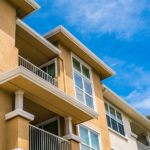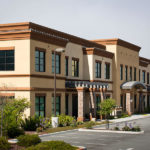Termite Treatment Guide & FAQs

MightyMite Termite Services is determined to offer our customers safe and reliable termite services and part of that determination is to keep you, the customer, well informed. Regardless of whether you choose MightyMite Termite Services or not, we want you to make a decision that is proper for you, your family, and your home. While MightyMite Termite Services is aware that we deal in the termite industry on a daily basis, you, the consumer, normally does not and may not have the basic knowledge to ask the correct questions to ensure you are getting the right service for your needs. MightyMite Termite Services has taken the time to provide you with the most commonly asked questions we feel homeowners should be asking their termite companies to extract the information necessary to make an informed decision on which company best suits their needs.
Some companies tell me to fumigate (tent) and some tell me to do spot treatment. What should I do?
The truth is every treatment has its own place in termite control. Tenting is designed to “wipe the slate clean” of all drywood termites from the tip-top of your home to the ground level, including areas your termite inspector cannot see into. One thing that hardly any termite company will ever tell you is that there is absolutely no residual effect associated with fumigation! There is NOTHING stopping drywood termites from flying into your home the minute after a tent is removed. When a company offers targeted spot treatment on a home, the treatment normally will offer some level of residual effect depending on the  product and application method they provide. Depending on a company’s warranty options, they can offer you better protection than that provided by a fumigation. Something to keep in mind though when choosing to perform targeted treatment is that a company can only perform targeted treatment on infestations of drywood termites they can find. The level of protection when it comes to drywood termite spot treatment is really built into the warranty that is offered by the individual companies.
product and application method they provide. Depending on a company’s warranty options, they can offer you better protection than that provided by a fumigation. Something to keep in mind though when choosing to perform targeted treatment is that a company can only perform targeted treatment on infestations of drywood termites they can find. The level of protection when it comes to drywood termite spot treatment is really built into the warranty that is offered by the individual companies.
MightyMite Termite Services offers a wide range of targeted spot treatment services as well as fumigation. This is extremely important for the integrity of our services as it allows us to customize each individual service to every single customer. If your home requires tenting, we will recommend it, and if we are able to gain control of your drywood termite infestation through alternative methods, we will recommend those.
As a consumer, you should be aware that there are very few scenarios where MightyMite Termite Services will recommend fumigation (tenting). Some key examples include but are not limited to:
- The homeowner requests it and is not interested in any sort of local treatment options.
- The costs associated with a tent (based upon the size of a structure) are far less than the cost of targeted treatment (based upon the level of activity in the structure)
- If there is an infestation in an area of the structure, we cannot physically apply a local treatment (for example: an infestation was seen in a 6-inch-tall attic space)
There are 2 kinds of termite inspections by State of California standards.
- “Limited Inspections”- a limited inspection is a partial inspection of a certain area of the structure.
- “Complete Inspections”- a complete inspection will include the entire interior, exterior, attic (if the structure has one), and the subarea/ crawlspace (if the structure has one)
A lot of companies advertise “Free Inspections” and only offer “Limited Inspections” as part of their free services. Here at MightyMite Termite Services, all of our inspections not used for a refinance or real estate transaction, are completely free. This includes Limited Inspections and Complete Inspections.
One thing that most companies are VERY vague about is the kinds of warranties other companies offer. Most companies want to focus on what they offer only and not expand on other potential warranty options available to the consumer. This is the exact reason why MightyMite Termite Services is presenting you with this document to educate you on how to shop properly for termite control.
If a company is offering you targeted treatment for what comparably seems like a much lower price to another company that is also offering targeted treatment, perhaps you should assess the warranty information being provided to you. In MOST CASES the cheaper rate is what is called a “limited warranty” and the more expensive treatment is called a “full structure warranty”
- “Limited Warranty”- A limited warranty will only warranty the individual areas treated and will define those individual areas as spot treated areas. The State of California defines a “spot treated area” as a “one foot by one foot” area.
- This means that if a new infestation site becomes apparent 13 inches or more away from the originally treated area after the treatment takes place with a “Limited Warranty”, that company can come back and charge you another fee to address that issue.

- This means that if a new infestation site becomes apparent 13 inches or more away from the originally treated area after the treatment takes place with a “Limited Warranty”, that company can come back and charge you another fee to address that issue.
- “Full Structure Warranty”– A full structure warranty will cover the entire structure. This will include areas that were not covered in the original inspection or treatment. This warranty will normally offer additional follow-up inspections of the entire structure, not just areas treated to ensure nothing new is occurring in your home. To the best of our knowledge there are 2 conventional ways of obtaining a full structure warranty for drywood termites in the San Francisco and Monterey Bay Area.
- Fumigation (Tenting)
- Contact one of the handful of companies that offer full structure warranty based off of targeted spot treatment. MightyMite Termite Services is proud to be one of those companies that offer a full structure warranty through targeted spot treatment with no move out required once a full structure inspection has taken place.
ALWAYS ASK YOUR TERMITE INSPECTOR IF THE SERVICE THEY ARE RECOMMENDING IS GIVING YOU A LIMITED WARRANTY OR FULL STRUCTURE WARRANTY.
- When you initially contact the company that is advertising “Free Inspections” ask them if it is a free “Full Inspection” or if the inspector will only look at the area where you are seeing activity. A lot of companies offering “Free Inspections”, show up to your home, you will show them one area of drywood termite infestation, and they will measure your home for a fumigation. The reason behind this simply is because that is what their company offers for control of drywood termites.
 In the State of California, a termite company only needs to find a singular termite dropping to recommend fumigation, and to measure a home for a fumigation takes 5-15 minutes. Therefore, a “Free Inspection” that takes 5-15 minutes to recommend fumigation, that doesn’t require a company to identify each individual infestation site to perform spot treatment allows for those companies to advertise “free inspections” even though they are not performing “Full Inspections”.
In the State of California, a termite company only needs to find a singular termite dropping to recommend fumigation, and to measure a home for a fumigation takes 5-15 minutes. Therefore, a “Free Inspection” that takes 5-15 minutes to recommend fumigation, that doesn’t require a company to identify each individual infestation site to perform spot treatment allows for those companies to advertise “free inspections” even though they are not performing “Full Inspections”. - If you are interested in having a full inspection performed for free, contact us at MightyMite Termite Services.
 We specialize in full home termite inspections as a way of obtaining a full structure warranty. We will inspect not only the entire interior and exterior of your home, but also the attic and the crawlspace. Keep in mind that there are other kinds of termites in this area that tenting doesn’t take care of and may be missed if only a limited inspection takes place.
We specialize in full home termite inspections as a way of obtaining a full structure warranty. We will inspect not only the entire interior and exterior of your home, but also the attic and the crawlspace. Keep in mind that there are other kinds of termites in this area that tenting doesn’t take care of and may be missed if only a limited inspection takes place.
The truth is that most companies aren’t going to trust other companies’ inspectors that they found or identified everything correctly. Also, as you can tell from the rest of this article, many companies offer different options when it comes to treatment and warranty options. It is in your best interest to have a full assessment by a company to get the best professional judgment performed by a well-trained inspector with eyes on your property.
SPECIAL TIP FROM AN INSPECTOR: If you have decided to get a tent and are trying to get comparative pricing, do not call companies and ask them to bid for a job based upon another company’s report. Ask the first inspector who recommended tenting how many “Cubic Feet” they measured your home at. Then call various companies and ask how much they would charge for a fumigation on a structure that measures at that many cubic feet. Then have the company that tells you the cheapest price out to your home to write you up a formal quote. This will save you time from having multiple fumigation quotes provided to you by various companies out to your home at various appointment times.
- XT-2000 Orange Oil Plus or as it is more commonly known to the public “Orange Oil” is a fermented oil derivative from orange rinds that produces a product called D-limonene.
- Orange Oil drywood termite treatments are designed specifically for when a termite company can identify where a drywood termite infestation starts and ends. If there is ANY potential of the infestation progressing into an area where an inspector cannot see into (behind sheetrock, between floorboards, into tight attic spaces, etc.) it is STRONGLY suggested to perform a different treatment method. MightyMite Termite Services offers a wide range of various spot treatment methods to customize services for your home.
- Orange Oil is a very quick contact kill, however, has a very short residual effect (3-8 days). This means that if your termite company doesn’t encompass the ENTIRE infested site with an Orange Oil treatment, there is a strong possibility of reinfestation of the same areas.
 MightyMite Termite Services’ flagship product was XT-2000 Orange Oil Plus and our logo is “Your Local Orange Oil Expert”. Unfortunately, part of our job being an expert in a product is knowing when it works and knowing when it doesn’t work. However, acting as professionals, we have a responsibility to our customers to customize our services to offer the best possible services to them. So, when it is possible to maintain good control through the use of Orange Oil, we will in fact offer this product, however, we do offer a wide range of targeted treatment options with no move out required.
MightyMite Termite Services’ flagship product was XT-2000 Orange Oil Plus and our logo is “Your Local Orange Oil Expert”. Unfortunately, part of our job being an expert in a product is knowing when it works and knowing when it doesn’t work. However, acting as professionals, we have a responsibility to our customers to customize our services to offer the best possible services to them. So, when it is possible to maintain good control through the use of Orange Oil, we will in fact offer this product, however, we do offer a wide range of targeted treatment options with no move out required.
Drywood Termites

- Drywood Termites live inside of the wood of your home and have relatively smaller sized colonies.
- Colonies are treated through either targeted treatment or through full structure fumigation (tenting).
- Well established colonies typically can eat the equivalent of 1 foot of 2×4 per year of wall framing.
Subterranean Termites

- Subterranean Termites live in the soil under and around your home.
- Subterranean Termites are the most destructive termites we have in this area and colonies can range in the millions.
- Colonies are treated by applying products to the soil around and under your home into the soil along the perimeter of your foundation wall.
- Tenting does not eliminate subterranean termites. This is very important to remember when you get your inspection, and an inspector only measures your home for fumigation. It is possible that only getting your home fumigated could potentially be getting rid of a small portion of the issues affecting your home.
- Some companies offer localized treatment for subterranean termites. However, while this can appear to be a cheaper option, it can be more costly, as it will allow for subterranean termites to infest other locations of your home, and cause you to incur additional costs. It is ALWAYS recommended, whenever possible, to perform full treatment for subterranean termites.
- Treatments for subterranean termites normally do not require you to have to move out of your home with MightyMite Termite Services.
Dampwood Termites

- Dampwood Termites, when they infest a home, live inside of the wood they infest. However, more times than not, whenever termite companies are called to homes to inspect due to dampwood termites, it is because of swarming termites. These swarming termites are usually from fallen trees or other organic materials in the surrounding areas of the home.
- Dampwood Termites can only live in wood members where there is a moisture condition with over 70% water retention. This usually means there is a leak of some sort whenever an active dampwood termite infestation is present in a home.
- The most reasonable treatment method to eliminate a dampwood termite infestation is to eliminate the water source that is allowing for the colony to survive. By eliminating the water source, the colony will die off naturally.
- Most dampwood termite colonies will also have a fungus damage issue associated with them due to the nature of water intrusion associated with necessity of their colony.
Wood Boring Beetles
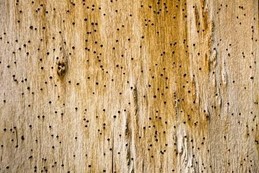
- Wood Boring Beetles are one of the most commonly misdiagnosed infestations by termite inspectors in the State of California.
- While there are hundreds of various types of “Wood Boring Beetles”, they get classified as 2 types.
- Re-infesting
- Re-infesting Wood Boring Beetles will continually burrow holes repeatedly into adjacent wood members and require treatment.
- Treatment methods include but are not limited to:
- Fumigation
- Targeted Spot Treatment
- Removal and replacement of infested wood pieces
- Non-Reinfesting
- Non-Reinfesting Wood Boring Beetles will spawn out of the wood once it is milled from the living tree in the forest and will not continue to cause damage. However, because the holes they leave on the exterior of the wood remains, some termite inspectors cannot tell the difference between the two classifications of infestations, and refer to the “Non-Reinfesting Beetles” as “Reinfesting”. Unfortunately, this leads to misdiagnosed infestations, and thousands of dollars spent on treatments by the homeowners that are not necessary in a lot of cases.
- Re-infesting
- Only Re-Infesting Wood Boring Beetles require treatment.
- There are ways to tell if your infestation is Re-infesting or Non-Reinfesting
- If the adjacent wood members also have pin sized holes—Reinfesting.
- If only a singular piece of wood in an area has pin sized holes—Non-reinfesting.
- If vibration on the wood causes a fine powder to fall from the pin sized holes—Re-infesting
- If there is a line of fine powder under the piece of wood that accumulates over time—Re-infesting
- There are ways to tell if your infestation is Re-infesting or Non-Reinfesting
SPECIAL TIP FROM AN INSPECTOR: Over 95% of beetle infestations can be handled with targeted treatment. Beetle tenting costs nearly 3x the cost of a drywood termite fumigation. It is highly recommended to get a second opinion if someone is recommending you get a beetle fumigation.
Fungus
Fungus is caused by water, and water works in 4 stages when it comes in contact with wood.
- Water Stain
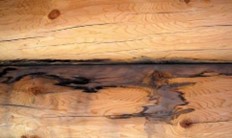
- A water stain as indicated in the name is just a marking on the outside of the wood indicating the water has gotten wet. No structural damage has occurred in the wood.
- Recommendation is to find and eliminate the source of the water to prevent future issues.
- Calcification or Mineralization or Effervescent
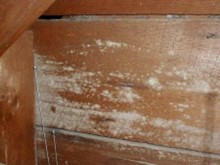
- Basically the wood has acted as a filter and the minerals from water have adhered to the outside surface of the wood. Again, no structural damage has occurred to the wood.
- Recommendation is to find and eliminate the source of the water to prevent future issues.
- Surface Fungus
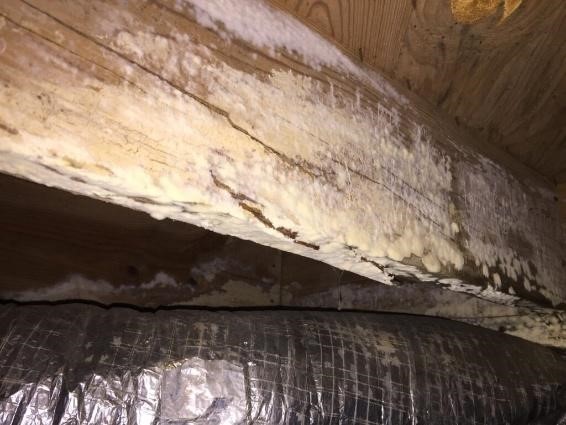
-
- At this point, there is now a living/breathing fungus growing on the outside surface of the wood. As moisture is presented to it, it will continue to grow and can proceed to break down the fibers of the wood. This will eventually progress into the next stage of water infiltration.
- Recommendation is to scrape the infected area down to raw wood with a wire brush, and to treat the area with a borate solution to prevent future fungal growth, and to find and eliminate the source of the water to prevent future issues.
- Fungus/ Dryrot

-
- At this point the fungus has now broken down the fibers of the wood and is considered to be structurally unsound. Every time moisture is presented to this area the damage can grow. This can be caused by a leaking area of your roof, a plumbing issue, or even a design flaw in your home.
- Recommendation is to contact the appropriate tradesperson to remove and replace the damaged wood members, and eliminate the source of the water to prevent future issues.
Damages (Fungus/ Dryrot, Termite, Wood Boring Beetles, etc.)
- The State of California defines “Damage” from termites and wood boring beetles as “When more than 20% of the thickness of a piece of wood is missing, due to an infestation, it is considered structurally damaged and should be removed, replaced, or repaired.
- When a piece of wood is damaged from fungus/ dryrot in any capacity, it should be removed, replaced, or repaired.
- A licensed termite company is legally allowed to repair damaged wood associated with a wood destroying organism without the standard contractor’s license.
- As a homeowner, you should know that you do not have to use a termite company to perform the repairs associated with a termite report. You can use any person willing to perform the repairs. However, if you are selling your home, and require a termite company to sign off on the repairs, be sure the repairs are completed to the fullest possible standard to ensure the damage is being removed entirely.
- Don’t panic.
- Termites will not bite you. While a large swarm of termites can be scary, they will not harm you.
- Try to collect a few of the flying termites in a Ziplock bag or a clear jar.
- Try not to squish them.
- Homeowners always try to tell inspectors “I had the flying kind of termites”
- All 3 kinds of termites in Monterey and San Francisco Bay area fly

- All 3 kinds of termites in Monterey and San Francisco Bay area fly
- Contact a reputable termite company to inspect your home for termites. Be sure to show them the sample of the flying termites you collected.
- Certain times of the year will generate swarming termites from different species.
- The temperature, humidity and time of the year will dictate which type of termites are flying around your home.
There are multiple answers to this question
- Timing Options for Inspection
- Before you start construction
- By performing an inspection prior to construction, you allow for an inspector to identify infestations as your home currently sits, prior to anything getting moved around, shifted, or covered up.
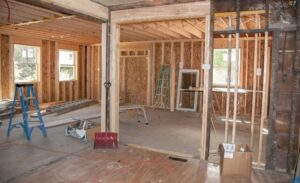
- Also, by performing the inspection prior to any infestations getting covered up by construction, it allows for an inspector to provide you with the most options.
- Performing a fumigation for drywood termites is recommended after all repairs take place. Most companies won’t want to tell you this because they want to make their money as soon as possible. However, in some rare occasions, lumber from the lumberyards can have termites inside of it. So MightyMite Termite Services suggests performing tenting (If that is the course of action being taken) to take place after the course of the repairs, to ensure all drywood termites have been eradicated from the structure.
- If it is determined that performing spot treatment is the best course of action, it is recommended to perform the treatment prior to the start of the repairs. MightyMite Termite Services full structure warranty will protect you in case your contract finds additional activity during the course of the remodel from any additional costs associated with termite treatment costs.
- If subterranean termites are found during the course of the inspection, it is recommended you perform the treatment right away, as they can cause damage in a short period of time. Here at MightyMite Termite Services, we assume our customers would prefer the termites not to cause damage to their newly remodeled home over such a short period of time.
- By performing an inspection prior to construction, you allow for an inspector to identify infestations as your home currently sits, prior to anything getting moved around, shifted, or covered up.
- Before you start construction
- During Construction
- Inspections during construction can be thorough because a lot of normally inaccessible wood members are now visible.
- Due to construction dust and debris, termite evidence may be difficult to detect.
- Contractors are notorious for attempting to “treat” termite with Copper Naphthenate (Copper Green). While copper green is an excellent wood preservative and termite preventative, once the termite colony is established, it will not wipe out an entire termite colony, and can force the termites into other areas of the home.
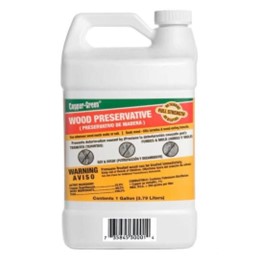
- Contractors do not like stopping what they are doing to allow for termite companies to perform their work.
- Termite treatment can be an unexpected cost in the middle of a rather expensive remodel job.
- After Construction
- After construction, these are the type of inspections that more often than not end up with a fumigation (tent) recommendation. This stems from a homeowner who was informed of a drywood termite infestation during a remodel project, which has been covered up during the remodel, and now the only option to eliminate the infestation is to fumigate the entire structure.
- Without being able to identify the extent of an infestation, a company that specializes in targeted treatment is unable to offer targeted treatment as an option.
- Inspections during construction can be thorough because a lot of normally inaccessible wood members are now visible.

